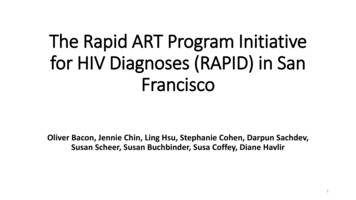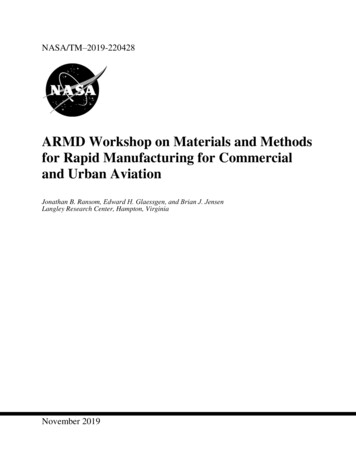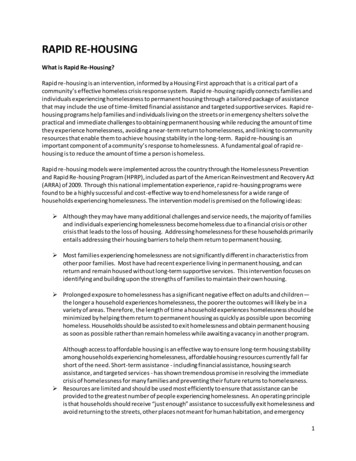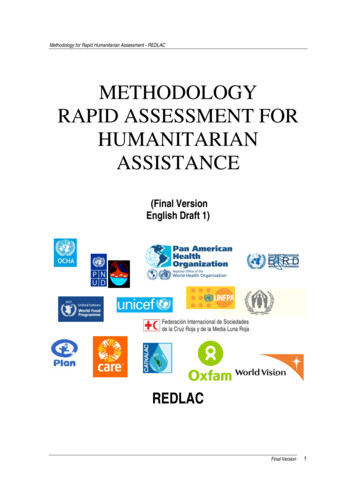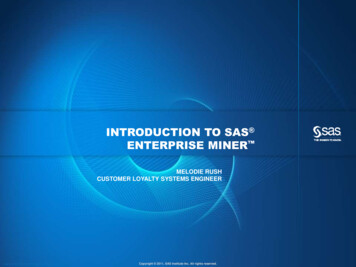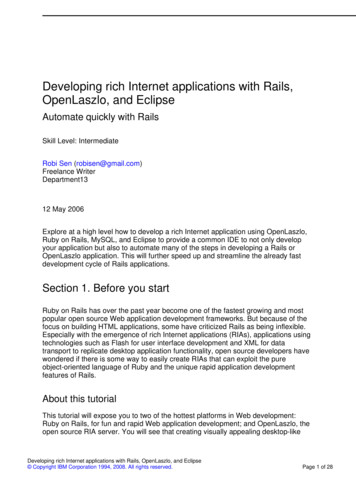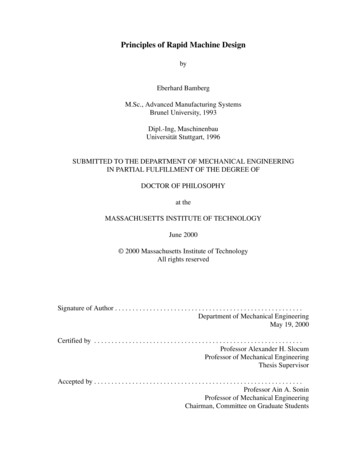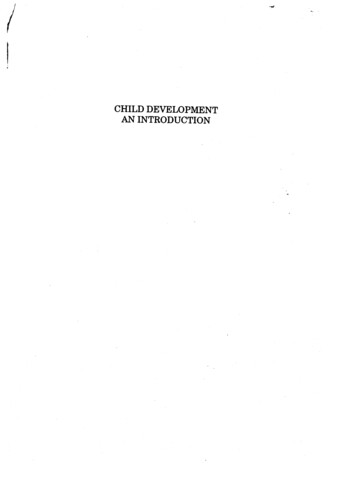
Transcription
RESEARCH ARTICLEOpen AccessVeterinary World, EISSN: 2231-0916Available at Development of a rapid and reliable high-performance liquidchromatography method for determination of water-soluble vitamins inveterinary feed premixMd. Zahangir Hosain, S. M. Shariful Islamand Md. Mostofa KamalQuality Control Laboratory, Department of Livestock Services, Savar, Dhaka-1343, Bangladesh.Corresponding author: Md. Zahangir Hosain, e-mail: zhosain79@gmail.comCo-authors: SMSI: sharifdls1975@gmail.com, MMK: mostofa.kamal.phd@gmail.comReceived: 12-08-2021, Accepted: 01-11-2021, Published online: 08-12-2021doi: www.doi.org/10.14202/vetworld.2021.3084-3090 How to cite this article: Hosain MZ, Islam SMS, Kamal MM (2021)Development of a rapid and reliable high-performance liquid chromatography method for determination of water-solublevitamins in veterinary feed premix, Veterinary World, 14(12): 3084-3090.AbstractBackground and Aim: Determination of trace amounts of vitamins in multi-component feed premix is a troublesomeanalytical procedure. In this study, a simple and rapid high-performance liquid chromatography (HPLC) method wasdeveloped and validated for the concurrent detection and quantitation of four water-soluble vitamins such as thiamine,riboflavin, pyridoxine, and cyanocobalamin in veterinary feed premixes.Materials and Methods: The chromatographic separation of the vitamins was carried out at 35 C temperature on areversed-phase C18 column using a gradient pump mode. Mobile phase constituents were solvent (a): 25 mM Potassiumdihydrogen phosphate and 5 mM sodium hexanesulfonate in deionized water having pH-4.0 and solvent and (b) 5 mMsodium hexanesulfonate in methanol. Detection was performed with HPLC ultraviolet/visible detection set at 278 and361 nm wavelength in two different channels. The flow rate was 1.2 mL/min and the total run time was 25 min.Results: The method was validated according to the International Conference on Harmonization and Food and DrugAdministration guidelines and acceptance criteria for system suitability, precision, linearity, and recovery were met in allcases. The relative standard deviation for system suitability and precision was 2% for all vitamins. The linearity of thecalibration curves was excellent (R2 0.999) at concentration of 5, 10, 15, 20, 25, and 30 µg/mL for all vitamins. The limits ofdetection values were 0.0125, 0.0017, 0.0064, and 0.0065 µg/mL for thiamine, riboflavin, pyridoxine, and cyanocobalamin,respectively, and the limits of quantification values were 0.0378, 0.0051, 0.0213, and 0.0198 µg/mL for thiamine, riboflavin,pyridoxine, and cyanocobalamin, respectively. The recovery percentages ranged from 88% to 115%.Conclusion: The overall parameters of the proposed method met the validation criteria and this method could be a highlydesirable technique for routine analysis of water-soluble vitamins in veterinary feed premix.Keywords: method development, veterinary feed-premix, water-soluble vitamin.IntroductionVitamins are critical and biologically activeorganic compounds that are minor but essential constituents of food required for normal metabolism in humanand animal bodies [1,2]. Feed premixes have beenwidely used in animal nutrition and the manufacture ofa feed premix is a significant aspect of veterinary feedproduction [3]. Even the premixes are designed for themarket or used directly for feed production; it is necessary to achieve homogeneity and well balanced of allingredients. Different types and quantities of micro-ingredients such as vitamins have been used in feed premix production depending on species and categories ofanimals [4]. Nowadays, contemporary feed productionis inconceivable without adding vitamin-mineral premixes. Although, a trace amount of vitamins is requiredCopyright: Hosain, et al. Open Access. This article is distributed underthe terms of the Creative Commons Attribution 4.0 censes/by/4.0/),whichpermits unrestricted use, distribution, and reproduction in anymedium, provided you give appropriate credit to the originalauthor(s) and the source, provide a link to the Creative Commonslicense, and indicate if changes were made. The Creative CommonsPublic Domain Dedication waiver ) applies to the data made available in thisarticle, unless otherwise stated.Veterinary World, EISSN: 2231-0916 in the diet they are considered essential and their effectson animal performance are vast [5]. There are twogroups of vitamins, namely, water-soluble vitamins andfat-soluble vitamins [6]. Water-soluble vitamins such asthiamine, riboflavin, pyridoxine, and cyanocobalaminare involved in many biochemical pathways and help inenergy metabolism [7]. However, they only are storedin small amounts and immediately lost with the flow offood or discharged with urine [8]. Therefore, the bodyneeds a continuous supply of water-soluble vitaminsto prevent deficiency symptoms and maintain normalbody function.Water-soluble vitamins have been extensivelyused as vitamin-mineral feed premix in animal production, especially in the poultry industry. The necessity of balanced vitamin-mineral premix in the poultrysector is increasing day by day to optimize the dietcompositions and meet the demand of modern poultry production [9]. While vitamin plays a minimalpart relative to complete nutrition, they have a keyrole in the welfare and performance of poultry, alongwith supporting crucial body functions such as growthperformance, reproduction, and immunity [10].Finished feed is incomplete without supplementation3084
Available at of vitamins and minerals, and it is very important toadd a premix in poultry feed to achieve a sufficientlevel of vitamins and minerals and to prevent the birdsfrom becoming malnourished [11]. They are also usedfor reducing diseases in animals and poultry [12].Although the veterinary vitamin-mineral premixes arean important requirement for the rapid and sustainablegrowth of poultry and livestock production, the question raises about their standard and quality.However, precise and routine analysis ofwater-soluble vitamins in veterinary feed premixis challenging due to the complex composition andunstable nature of the target analytes. Many factors canaffect the stability of these vitamins such as heat, light,pH, air as well as interactions with other feed components [13,14]. Furthermore, the extraction of these vitamins involves pretreatment through complex chemicalreactions, and then a separate method to determineeach vitamin. Therefore, the development of a validated analytical method to determine each componentof water-soluble vitamins is comparatively a difficultanalytical procedure. Some analytical methods such asultraviolet/visible (UV/Vis) spectrophotometry, fluorimetry, chemiluminescence, capillary electrophoresis,thin-layer chromatography, and liquid chromatographyhave been offered for the determination of water-soluble vitamins [15,16]. Among these, high-performanceliquid chromatography (HPLC) appears promising dueto the advancement of both stationary phases and chromatography equipment [17].The liquid chromatography technique has beenwidely applied for vitamin analysis from differentmatrices with some drawbacks such as low reproducibility, longer retention time, and complex mobilephases associated with longer column equilibration, and the total run time of the analysis upper to60 min [18,19]. Due to the complex composition ofthe veterinary feed premix and the unstable nature ofsome vitamins, the extraction and analysis procedureis tedious and time-consuming; sometimes, a specialpreparation technique is required to obtain the analytecontained in the sample matrix [20]. For this reason,very few standards and validated methods are available for the quantification of water-soluble vitaminsin veterinary feed premix.Hence, the current study aimed to develop asimple, rapid, and validated HPLC technique for thedetermination of water-soluble vitamins such as thiamine (B1), riboflavin (B2), pyridoxine (B6), and cyanocobalamin (B12) in veterinary feed-premix.Materials and MethodsEthical approvalThe present study did not need contact withanimals. Hence, ethical approval did not require inthis study.Study period and locationThe study was conducted from December 2019to July 2021 in the Quality Control Laboratory,Veterinary World, EISSN: 2231-0916 Department of Livestock Services (DLS), Dhaka,Bangladesh.Chemicals and reagentsPotassium dihydrogen phosphate (KH2PO4),sodium hexanesulfonate, and methanol (HPLC grade)used in this study were purchased from Sigma-Aldrichand certified reference standard (CRS) of thiamine(Code: Y0000467, Batch: 2.3, ID: 003qpE), riboflavin (Code: R0600000, Batch: 5.0, ID: 007Auc), pyridoxine hydrochloride (Code: P4100000, Batch: 2.0,ID: 001UF1), and cyanocobalamin (Code: C3000000,Batch: 6.0, ID: 00EbaR) were purchased from EuropianPharmacopoeia Reference Standard, Council of Europe,EDQM CS 30026F-67081, Strasbourg, Cedex. Doubledeionized (DI) water used in this study was obtainedfrom a water deionization plant (ePure-D4642-33,Thermo, USA). All solutions were sonicated and filtered through a 0.45 mm filter using a vacuum filtrationunit (Welch, Pall Scientific, USA) before use.HPLC methodThe high-performance liquid chromatographicsystem (Waters alliance, Model-e2695XC separationmodule, 2489 UV/Vis Detector, Waters Corporation,USA) with a data processing unit Empower-3 software was used in this study. HPLC column WatersX-Bridge (4.6 150 mm), 5 µM Packing C18 was usedfor the separation of vitamins. A gradient pump modewas used where 25 mM KH2PO4 and 5 mM sodiumhexanesulfonate in water having pH-4.0 adjusted withphosphoric acid was used as mobile phase-A and 5mM sodium hexanesulfonate in methanol was used asmobile phase-B. The flow rate and injection volumeswere 1.2 mL/min and 20 µL, respectively, and thecolumn temperature was maintained at 35 C. Wavelength of detection was 278 nm (Channel-A) for thiamine, riboflavin, pyridoxine, and 361 nm (Channel-B)for cyanocobalamin. The whole chromatography wasperformed at ambient temperature.Preparation of standard solutionWeighed accurately 10 mg from each ofthiamine, riboflavin, pyridoxine, and cyanocobalaminCRS and transferred into four 100 mL amber colorvolumetric flasks separately. Initially, 30 mL of DIwater were added to each flask and the contents wereshaken vigorously by a vortex mixer for 3 min andsonicated for 10 min in an ultrasonic bath. Then, thesolutions were diluted to volume with DI water andmixed thoroughly by vortex mixer. These solutionswere used as reference stock standard solutions andkept in a refrigerator for further use. Working standardsolutions were prepared from stock standard solutions. Before injecting into the liquid chromatographysystem, the solutions were filtered through a 0.45 μmpolyvinylidene difluoride ( PVDF) syringe filter.Preparation of sample solutionThe procedure of standard solution andsample preparation was almost the same. Briefly,5.0 g of veterinary feed-premix enriched with3085
Available at thiamine, riboflavin, pyridoxine, and cyanocobalamin was accurately weighed and transferred intoa 100 mL amber color volumetric flask. Initially,30 mL of DI water were added to the flask and thecontents were shaken vigorously by a vortex mixerfor 3 min and sonicated for 10 min in an ultrasonicbath. Then, the content was diluted to volume withDI water and mixed thoroughly by a vortex mixerfor 3 min. Thereafter, the mixer was filtered withWhatman 1 Filter paper. Finally, the sample solution was transferred into the sample vial after filtering with a 0.45 µm PVDF syringe filter for liquidchromatography.Method validation parametersMethod validation of the present study was performed by measuring the basic parameters of the validation process such as system suitability, precision,linearity, limits of detection (LOD), limits of quantification (LOQ), and recovery. The validation parameters were evaluated using recommended guidelinesof the International Conference on Harmonization(ICH) [21] and the United States Food and DrugAdministration (FDA) [22,23].System suitabilityThe system suitability was evaluated by six replicate analyses of a standard aqueous mixture of allvitamins. The acceptance limit of the different parameters for system suitability of the method is calculatedaccording to the guidelines of ICH and FDA wherethe acceptance criteria are the percentage of relativestandard deviation (RSD) for retention time and peakarea (PA) is 2%, the number of theoretical plates(TP) more than 2000, tailing factor (TF), and peak resolution (RS) 2.PrecisionThe precision of the method was evaluatedbased on repeatability and intermediate precision. Therepeatability was calculated on the results obtainedfrom the same day for six independent mixer solutions of the same concentration (10 µg/mL) and theintermediate precision was evaluated by calculatingthe repeatability of the same concentration (10 µg/mL) by two analysts on different days. The percentageof RSD was calculated for estimating the precision ofthis study.LinearityTo evaluate the linearity, six standard mixturesof thiamine, riboflavin, pyridoxine, and cyanocobalamin were prepared and a linear equation was established for each vitamin by plotting the PAs versusthe concentrations. Three calibration curves wereobtained on three consecutive days with a specifiedstandard concentration of each vitamin. Linearitywas calculated by running six standard mixtures ofeach vitamin, at final concentrations of 5, 10, 15, 20,25, and 30 µg/mL.Veterinary World, EISSN: 2231-0916 LOD and LOQThe lowest qualitative and quantitative concentrations for the tested linearity range were calculatedfor each vitamin according to the guidelines of ICH2000. Both LOD and LOQ were calculated using theexpression: k x S.D/b, where k 3.3 for the LOD and10 for the LOQ, S.D The standard deviation of theintercept, and b Slope of the calibration curve testedfor linearity.RecoveryThe recovery studies were carried out by spikingdifferent amounts (80%, 100%, and 120%) of eachvitamin in the pre-analyzed formulation blank matrixsample along with the linearity range. For the estimation of recovery, an accurate amount of each vitaminat three concentration levels (8, 10, and 12 µg/g) wasadded to approximately 1.0 g of blank matrix powder,and then the powder was extracted and analyzed forrecovery using the formula: recovery (%) (amountobtained/amount spiked) 100.Statistical analysisData collected in this study were analyzed usingStatistical Package for the Social Sciences version 16statistical package by one-way analysis of varianceand by independent samples Student’s t-test. Linearregression analysis was performed using the leastsquare method.Results and DiscussionThis study demonstrates the development andvalidation of a precise analytical method wherethe validation criteria [21-23] met in all cases.Representative chromatograms of standard solution and a real feed premix sample are depictedin Figure-1a and b, respectively. The elution ofwater-soluble vitamins through the analytical column occurs in a specific order and in groups thatdepend on their chemical properties [24]. Asexpected, polar vitamins (pyridoxine and thiamine)elute first, followed by low-polar vitamins (cyanocobalamin and riboflavin). The retention time ofthese four water-soluble vitamins was as follows:9.34 0.01 min (pyridoxine), 12.55 0.01 min (thiamine), 13.16 0.01 min (cyanocobalamin), and14.67 0.01 min (riboflavin).The system suitability parameters (Table-1)reveal that the percentage of RSD for retention timeand PA is 2%, the number of TP is more than 2000,and TF and RS are 2, which prove that the valuesare within the specified limits of the validation process [21-23]. The precision for the method and analyst was evaluated that are shown in Tables-2 and 3.The results reveal that the RSD value for both casesis 2%, which indicates that the proposed methodhas good reproducibility. From the linearity ofFigure-2 and Table-4, it is found that all of the vitamins maintain excellent linearity (R2 0.999) within3086
Available at abFigure-1: Typical chromatogram of vitamins mix analyzed under standardized conditions. (a) Chromatogramsof thiamine, riboflavin, pyridoxine (at 278 nm), and cyanocobalamin (at 361 nm) mixed standard solution;(b) chromatograms of thiamine, riboflavin, pyridoxine (at 278 nm), and cyanocobalamin (at 361 nm) in sample solutionof real veterinary feed premix.Table-1: System suitability parameters of the proposed high‑performance liquid chromatography method.VitaminRT (min)% RSDof RTPeak Area% RSD ofPeak AreaTheoreticalplatesTailing factorResolutionThiamine (B1)Riboflavin (B2)Pyridoxine (B6)Cyanocobalamin (B12)12.55 0114.67 019.34 0113.16 .43‑7.28RT Retention time, RSD Relative standard deviationthe concentration range of 5-30 µg/mL. The lowestqualitative and quantitative concentrations for thetested linearity range were calculated for each vitamin. The LOD for thiamine, riboflavin, pyridoxine,and cyanocobalamin is found to be 0.0125, 0.0017,Veterinary World, EISSN: 2231-0916 0.0064, and 0.0065 µg/mL, respectively, and theLOQ for thiamine, riboflavin, pyridoxine, and cyanocobalamin is found to be 0.0378, 0.0051, 0.0213,and 0.0198 µg/ mL, respectively, (Table-5). Fromthe results shown in recovery Table-6, it is observed3087
Available at that the percentage recovery values of all the vitamins are between 88% and 115%, which suggeststhat the method is accurate and it also indicates thatthe commonly used excipients and additives presentin the feed premix formulations are not interferingTable-2: Precision under repeatability conditions (n 6).VitaminThiamine (B1)Riboflavin (B2)Pyridoxine (B6)Cyanocobalamin (B12)Retentiontime % RSDArea% RSD0.070.070.080.080.830.470.630.39RSD Relative standard deviationthe proposed method. Many HPLC methods havebeen published concerning the simultaneous determination of vitamins, but most of the methods are notstable [25-27] which indicates the methods were notproperly assessed during stability studies, and someof them are unable to quantify all the water-soluble vitamins simultaneously. Some stable methodswere [27,28] reported for the simultaneous quantification of seven water-soluble vitamins in multivitamin syrup preparations but they are unable to analyzecyanocobalamin. Few studies mention the methodsof MS-MS detector [27,29], which involves specificand expensive equipment that is not available in alllaboratories for routine analysis of these water-solubleTable-3: Intermediate precision (n 6).VitaminFirst analystSecond analystRetention time % RSDArea % RSDRetention time % RSDArea % 90.130.090.150.10Thiamine (B1)Riboflavin (B2)Pyridoxine (B6)Cyanocobalamin (B12)RSD Relative standard deviationTable-4: Regression parameters of analyzed water‑soluble vitamins (regression coefficient, R2) in calibration curves.VitaminRegression coefficient1 day2nd day3rd dayR2 0.9993R2 0.9998R2 0.9999R2 0.9998R2 0.9993R2 0.9996R2 0.9999R2 0.9998R2 0.9993R2 0.9997R2 0.9999R2 0.9998stThiamine (B1)Riboflavin (B2)Pyridoxine (B6)Cyanocobalamin (B12)acbdFigure-2: Calibration curve of (a) thiamine, (b) riboflavin, (c) pyridoxine, and (d) cyanocobalamin.Veterinary World, EISSN: 2231-0916 3088
Available at Table-5: LOD and LOQ values of thiamine, riboflavin, pyridoxine, and cyanocobalamin.VitaminLOD (µg/mL)LOQ 0.0198Thiamine (B1)Riboflavin (B2)Pyridoxine (B6)Cyanocobalamin (B12)LOD Limits of detection, LOQ Limits of quantificationTable-6: Recovery percentages of thiamine, riboflavin, pyridoxine and cyanocobalamin.VitaminSpike % of thevitaminSpiked 10128101281012Thiamine (B1)Riboflavin (B2)Pyridoxine (B6)Cyanocobalamin (B12)Obtained conc. (µg/g)1 Day 2vitamins. The method we developed is more precisewith good repeatability, intermediate precision, reproducibility, and has high accuracy for detection of allthe vitamins used in the study. The sample extractionprocedure in our proposed method is simple and quantification of water-soluble vitamins in the real samplesis also comparable to the declared values. Thus, thedeveloped method is a simple and reliable approachfor simultaneous detection and quantification of fourwater-soluble vitamins that have a wide range ofapplications in routine examination of veterinary feedpremix.ConclusionIn this study, a simple and precise analyticalmethod is developed with an HPLC column for rapidand reliable analysis of water-soluble vitamins in complex veterinary feed premix. The simple technique forsample preparation and mobile phase containing waterand methanol make the method more economical anddesirable for the quantification of water-soluble vitamins in feed premixes. The recovery of each vitaminwith the proposed procedure in the feed premix formulation is also high enough with their respective labelclaims. Therefore, this method could be a validatedanalytical procedure for accurate determination ofwater-soluble vitamins in multi-component veterinaryfeed premix and might be a precise technique to checkthe standard and quality of the feed premix intended tobe used for increased livestock 13.018.4510.2612.87Veterinary World, EISSN: 2231-0916 DayAverage obtainedconc. (µg/g)Averagerecovery 812.0714.527.969.8712.07MMK: Edited and finalized the manuscript. Allauthors read and approved the final manuscript.AcknowledgmentsThe authors are thankful to the “Quality ControlLaboratory for Livestock Inputs and its Food Products(QC Lab)” establishment project (No. 224071600)under the Department of Livestock Services,Government of Bangladesh, for providing the necessary funds for the study. We are grateful to Kazi IqbalMahmud Sonet and Md. Anwar Hossain, AnalyticalDivision, Technoworth Associates Ltd., Bangladesh,for their technical support. We also thank Dr. HabibaMargia Khanam, Genesis Medical Clinic, Calgary,Alberta, Canada, for editing a draft of this manuscript.Competing InterestsThe authors declare that they have no competinginterests.Publisher’s NoteVeterinary World remains neutral with regardto jurisdictional claims in published institutionalaffiliation.References1.2.Authors’ ContributionsMZH: Conceptualized and designed the study.MZH and SMSI: Generated the data. MZH and SMSI:Analyzed the data. MZH: Drafted the manuscript.Day .42rd3.Poongothai, S., Ilavarasan, R. and Karrunakaran, C. (2010)Simultaneous and accurate determination of Vitamins B1,B6, B12 and alpha-lipoic acid in multivitamin capsule byreverse-phase high performance liquid chromatographicmethod. Int. J. Pharm. Pharm. Sci., 2(4): 133-139.Kennedy, D.O. (2016) B Vitamins and the brain:Mechanisms, dose and efficacy-a review. Nutrients,8(2): 68.Rubaj, J., Korol, W. and Bielecka, G. (2012) UsingHigh Performance Liquid Chromatography (HPLC) forAnalyzing Feed Additives. Chromatography-the MostVersatile Method of Chemical Analysis. p165.3089
Available at 4.5.6.7.8.9.10.11.12.13.14.15.16.17.18.Đuragić, O., Lević, J., Sredanović, S., Ivanov, D. andKokić, B. (2009) Importance of carrier for feed premixesproduction. PTEP, 13(4): 324-327.Tian, J.Z., Lee, J.H., Kim, J.D., Han, Y.K., Park, K.M. andHan, I.K. (2001) Effects of different levels of Vitaminmineral premixes on growth performance, nutrient digestibility, carcass characteristics and meat quality of growing-finishing pigs. Asian-Aust. J. Anim. Sci., 14(4): 515-524.Lykstad, J. and Sharma, S. (2019) Biochemistry, WaterSoluble Vitamins. StatPearls Publishing, Treasure Island(FL), PMID: 30860745.Kienen, V., Costa, W.F., Visentainer, J.V., Souza, N.E.and Oliveira, C.C. (2008) Development of a green chromatographic method for determination of fat-soluble vitamins in food and pharmaceutical supplement. Talanta,75(1): 141-146.Almatsier, S. (2004) Prinsip Dasar Ilmu Gizi, Jakarta,Penerbit PT. Jakarta, Indonesia: Gramedia Pustaka Utama.Ogunwole, O.A. and Mosuro, A.O. (2020) Dietary vitamin-mineral premix replacement with leaf meal composites improved the growth performance of broiler chicken.Slovak J. Anim. Sci., 53(3): 110-121.Nakos, M., Pepelanova, I., Beutel, S., Krings, U.,Berger, R.G. and Scheper, T. (2017) Isolation and analysis of Vitamin B12 from plant samples. Food Chem.,216 (3): 301-308.Alagawany, M., Elnesr, S.S., Farag, M.R., Tiwari, R.,Yatoo, M.I., Karthik, K. and Dhama, K. (2021) Nutritionalsignificance of amino acids, vitamins and minerals as nutraceuticals in poultry production and health-a comprehensivereview. Vet. Q., 41(1): 1-29.Yoshii, K., Hosomi, K., Sawane, K. and Kunisawa, J. (2019)Metabolism of dietary and microbial Vitamin B family inthe regulation of host immunity. Front. Nutr., 6: 48.Cellar, N.A., McClure, S.C., Salvati, L.M. and Reddy, T.M.(2016) A new sample preparation and separation combination for precise, accurate, rapid, and simultaneous determination of Vitamins B1, B2, B3, B5, B6, B7, and B9 in infantformula and related nutritional by LC-MS/MS. Anal. Chim.Acta., 934(33): 180-185.Schmidt, A., Pratsch, H., Schreiner, M.G. and Mayer, H.K.(2017) Determination of the native forms of Vitamin B1 inbovine milk using a fast and simplified UHPLC method.Food Chem., 229(16): 452-457.Arbatskii, A., Afon’shin, G. and Vostokov, V. (2004)Determination of vitamins in feed and foodstuffs byhigh-performance liquid chromatography. J. Anal. Chem.,59(12): 1186-1189.Rudenko, A. and Kartsova, L. (2010) Determination ofwater-soluble Vitamin B and Vitamin C in combined feed,premixes, and biologically active supplements by reversedphase HPLC. J. Anal. Chem., 65(1): 71-76.Moreno, P. and Salvado, V. (2000) Determination of eightwater-and fat-soluble vitamins in multi-vitamin pharmaceutical formulations by high-performance liquid chromatography. J. Chromatogr. A, 870(1-2): 207-215.Perveen, S., Yasmina, A. and Mohammed Khan, K. (2009)Quantitative simultaneous estimation of water soluble19.20.21.22.23.24.25.26.27.28.29.vitamins, riboflavin, pyridoxine, cyanocobalamin and folicacid in nutraceutical products by HPLC. Open Anal. Chem.J., 3(1): 1-5.Sasaki, K., Hatate, H. and Tanaka, R. (2020) Determinationof 13 Vitamin B and the related compounds using HPLCwith UV detection and application to food supplements.Chromatographia, 83(7): 839-851.Klejdus, B., Petrlová, J., Potěšil, D., Adam, V., Mikelová, R.,Vacek, J. and Kubáň, V. (2004) Simultaneous determination of water-and fat-soluble vitamins in pharmaceuticalpreparations by high-performance liquid chromatographycoupled with diode array detection. Anal. Chim. Acta., 520(1-2): 57-67.Shabir, G.A. (2005) Step-by-step analytical methods validation and protocol in the quality system compliance industry.J. Valid. Technol., 10: 314-325.FDA, Analytical Procedures and Methods Validation forDrugs and Biologics. (2015) Guidance for Industry, U. S.Department of Health and Human Services Food and DrugAdministration Center for Drug Evaluation and Research(CDER), Center for Biologics Evaluation and Research(CBER), Pharmaceutical Quality.Marson, B.M., Concentino, V., Junkert, A.M., Fachi, M.M.,Vilhena, R.O. and Pontarolo, R. (2020) Validation of analytical methods in a pharmaceutical quality system: Anoverview focused on HPLC methods. Química Nova,43(8): 1190-1203.Rakuša, Ž. T., Grobin, A. and Roškar, R. (2021) A comprehensive approach for the simultaneous analysis of allmain water-soluble vitamins in multivitamin preparationsby a stability-indicating HPLC-DAD method. Food Chem.,337(4 ): 127768.Langer, S. and Lodge, J.K. (2014) Determination of selectedwater-soluble vitamins using hydrophilic chromatography:A comparison of photodiode array, fluorescence, and coulometric detection, and validation in a breakfast cereal matrix.J. Chromatogr. B, 960(11): 73-81.Santos, J., Mendiola, J.A., Oliveira, M.B.P., Ibáñez, E. andHerrero, M. (2012) Sequential determination of fat-andwater-soluble vitamins in green leafy vegetables duringstorage. J. Chromatogr. A, 1261(43): 179-188.Chen, Z., Chen, B. and Yao, S. (2006) High-performanceliquid chromatography/electrospray ionization-mass spectrometry for simultaneous determination of taurine and 10water-soluble vitamins in multivitamin tablets. Anal. Chim.Acta., 569(1-2): 169-175.Vidović, S., Stojanović, B., Veljković, J., Pražić-Arsić, L.,Roglić, G. and Manojlović, D. (2008) Simultaneous determination of some water-soluble vitamins and preservatives in multivitamin syrup by validated stability-indicating high-performance liquid chromatography method. J.Chromatogr. A, 1202(2): 155-162.Jin, P., Xia, L., Li, Z., Che, N., Zou, D. and Hu, X. (2012)Rapid determination of thiamine, riboflavin, niacinamide,pantothenic acid, pyridoxine, folic acid and ascorbic acidin vitamins with minerals tablets by high-performance liquid chromatography with diode array detector. J. Pharm.Biomed. Anal., 70(12): 151-157.********Veterinary World, EISSN: 2231-0916 3090
Development of a rapid and reliable high-performance liquid chromatography method for determination of water-soluble vitamins in veterinary feed premix, Veterinary World, 14(12): 3084-3090. Abstract Background and Aim: Determination of trace amounts of vitamins in multi-com
